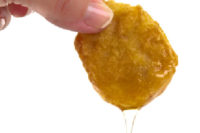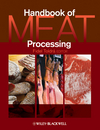Making and packaging a safer sausage

Cook-in-the-bag deli products were being made safer for consumers long before processors were aware of the risk of environmental contamination by Lm. Assuming that the cooking procedure provides sufficient lethality, there should be no Lm in the package up to the point that the package is opened by the end-user. This product has long been understood to have a shelf life that was more than twice as long as products that were exposed to the environment, before the final vacuum-packaging process. Using steam or water cooking methods, this product also cooks faster than the traditional oven-cooked products.
Moisture-impermeable casings have become more popular as a means to cook and distribute whole-
muscle products and luncheon meats without exposing the product to the environment between cooking and packaging. Smoke, spice, and surface coloring technologies have been developed to allow for the application of colors and flavors to the inside of the impermeable casings or pouches, so that products that were traditionally made in a smokehouse or oven could be made using a cook-in-the-bag process. In addition to the food-safety advantage, these products cook faster in hot water or steam than the traditional oven-cooked products.
More recently, the co-extrusion process for making sausage links has incorporated the cook-in-the-bag concept into the processing of sausage links. This has been accomplished by treating the surface of the links, so that they are firm enough to be loaded into the package for cooking. The final cooking of this product is done in the same package as is used for distribution to consumers, eliminating the chance for post-lethality environmental contamination by Lm.
Even more recently, the food-safety benefit of cook-in-the-bag technology has progressed to natural casing products. To accomplish this with natural casing links, these products are partially cooked (to about 130ºF internal), and smoked (either liquid or hardwood smoke), then loaded into retail packages, vacuum-sealed and cooked in either water or steam. The partial cooking allows time for smoking of the links and to firm up the link enough so that they can be handled during the packaging process. Grilling could potentially be used as the initial cooking step, to apply grill marks and surface browning to links that are not smoked.
In addition to the increased safety of this product, the shelf life of this fully cooked product is increased, some as high as 120 to 150 days.
This isn’t actually a new process, as some readers will remember. In the past, it was common to smoke natural casing links in a smokehouse, and then cook the links in hot water using a Jordan cooker.
One advantage to this process is that it can be adapted by smaller processors who are making natural casing products. For smaller volume production, it might also be adaptable for making skinless links. For larger processors, equipment and a process have been developed by ALKAR-RapidPak, Inc. (PureLink) to do this on a continuous basis.
A big advantage to this process is that the finished product isn’t exposed to the environment between the time of the lethality process and when the end-user opens the package. This means that this process is not subject to the “430 regulations (9 CFR Part 430)”. For products that are not post-lethality exposed, a Listeria control plan is not required, which means that the processor would not need to comply with the requirements included in one of the three Alternatives, and that antimicrobial agents may not need to be added to the product. This would apply to all of the products discussed earlier, in which the final cooking step is done in a vacuum-sealed bag.
This process would require a stable formulation, in order to prevent moisture and fat cookout in the package that your final consumer will see. Some products that are made entirely in an open oven may not adapt well to this process initially. Some products may require some process and/or ingredient improvements to improve the water and fat-binding capacity of the product to prevent fat and water from being cooked out of the product and trapped in the package.
One disadvantage to this process is that because the links aren’t fully cooked at the time of packaging, the packaging process would need to take place in either a separate room or at a separate time from the packaging of fully cooked products, to avoid cross-contamination. For larger processors, this process involves a dedicated line separate from the fully cooked product packaging lines.
Because the risk of environmental contamination is eliminated, when the product is not exposed post-
lethality, the product is not only safer, but the regulatory requirements for antimicrobial ingredients, post-lethality treatments, sanitation programs, and product testing are reduced. Although this concept is not without some challenges, it has the potential to be a win-win situation for everyone.
Looking for a reprint of this article?
From high-res PDFs to custom plaques, order your copy today!










